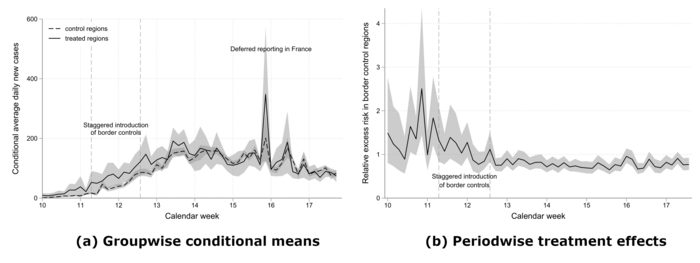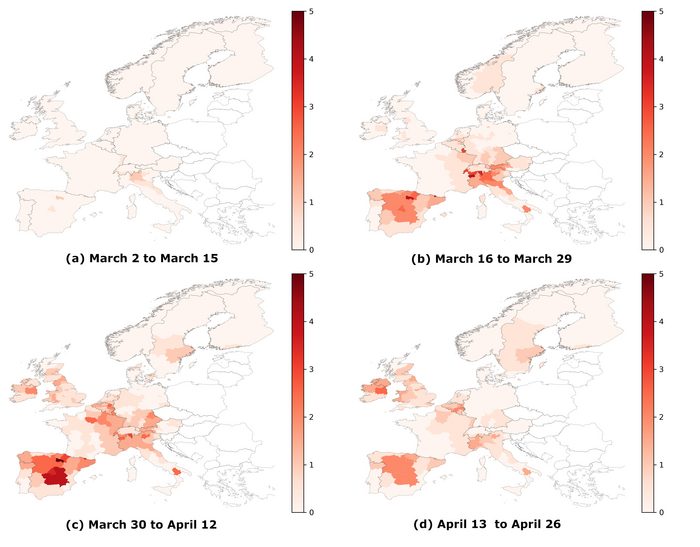


"Temporal border controls are costly but they helped to contain the spread of Covid-19 across Europe."
The Covid-19 pandemic led to a massive return of the nation state. National governments around the world took far-reaching measures to control the spread of the disease, whether just closing shops, restaurants, and schools, or a complete and total lock-down of public life. In Europe, the crisis was, and still is, a fundamental challenge to European Union principles, notably solidarity, policy coordination, and free movement across national borders. In this paper, we focus on the temporal reintroduction of national border controls within the Schengen area. While such restrictions clearly involve costs, the benefits are disputed.
Our main finding is that the temporal reintroduction of border controls within the Schengen area helped contain the spread of Covid-19. We use a new set of daily data of confirmed Covid-19 cases at the level of 213 European regions, compiled from the respective statistical agencies of 18 Western European countries. Our data runs from calendar week 10 (starting March 2, 2020) to calendar week 17 (ending April 26, 2020). Figure 1 shows developments over time.
Figure 1: Newly confirmed Covid-19 cases per 1,000 inhabitants in specified calendar weeks.
[insert image1]
Copyright Eckardt-Kappner-Wolf
With this data, we test for treatment effects of border controls on new Covid-19 cases. We do this in two steps. Controlling for regional specificities and country-wide variation in containment policies (based on an econometric model with region and country-time fixed effects), we show that border controls are associated with a 25% reduction in daily cases. Importantly, we show that border controls mattered only for regions with a substantial number of cross-border commuters prior to the crisis, which is missed in the existing literature. Figure 2 shows the number of daily new cases in treatment and control regions over time, conditional on day and region fixed effects (panel a) and the estimated excess risk in treated over control regions (panel b). Apparently, the introduction of controls helped to reduce the excess risk.
Figure 2: Panel 2a plots average daily new cases in the treatment and control groups, conditional on day and region fixed effects. Panel 2b shows (exponentiated) coefficients of the treatment group dummy for each day, conditional on country-day and region fixed effects. In both panels, gray areas show the 10 % confidence interval for robust standard errors clustered at the region level. Note that the “France spike” seen in panel 3a does not show up in panel 3b, because it is absorbed by the country-day fixed effects.
[insert image2]
Copyright Eckardt-Kappner-Wolf
In a second step, we show that it is important to consider unobserved spatio-temporal heterogeneity. This is likely to matter for at least two reasons. First, local containment policies might have differed from nation-wide measures and our information on such local measures is incomplete. Without such data, we might overestimate the effect of border controls. Second, our fixed effect regression approach is likely to miss some of the spatial dynamics in the data, as described by Tobler’s First Law of Geography: "Everything is related to everything else, but near things are more related than distant things." To deal with this, we use a Bayesian INLA approach. With this we model the idea that Covid-19 cases in one region will be affected by cases in neighboring regions. Moreover, we use this to control for unobserved variation across regions using spatial random effects. With this more flexible approach, we find smaller, but still significant, effects of border controls of about 6 %.
We conclude that the temporal introduction of border controls was certainly costly but made a measurable contribution to containing Covid-19. At the same time, it is likely that better policy coordination at the European level could have generated these benefits with lower economic (and political) costs; for example, if based on European economic clusters with a closer monitoring of cross-border commuting flows. Instead of closing national borders, a European agency could coordinate local containment policies in affected regions on both sides of an affected cluster.
Matthias Eckardt (HU Berlin)
Kalle Kappner (HU Berlin)
Nikolaus Wolf (HU Berlin)
The full paper “COVID-19 Across European Regions: The Role of Border Controls” is available as a working paper.
This text is jointly published by BSE Insights and BCCP.
Link to BCCP News Version of this Insight
Reference
Matthias Eckardt, Kalle Kappner and Nikolaus Wolf, “Covid-19 across European regions: The role of border controls”, CEPR DP 15178 and Covid Economics Vol 42, pp. 94-111.